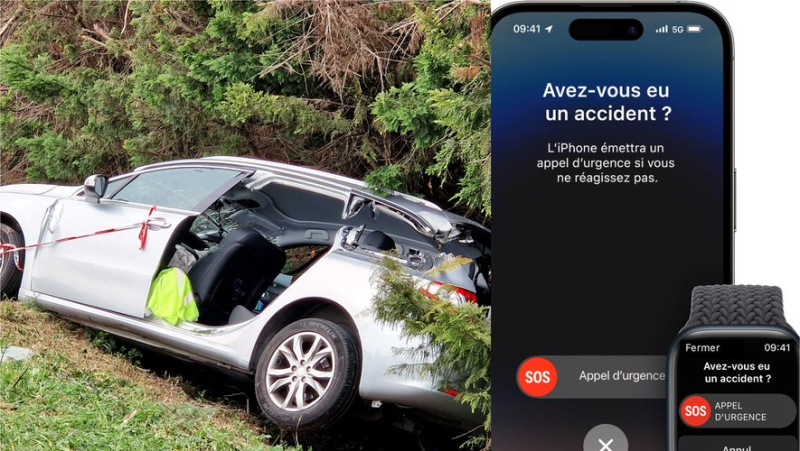Seriously Injured Driver in Toulouse Saved by His Smartphone: How iPhone Accident Detection Works ?

En cas d’accident, l’iPhone prévient les secours. C’est ce qu’il s’est produit ce week-end à Toulouse. ME et Apple
On the night of Saturday to Sunday, a 21-year-old man was the victim of a serious road accident. Our colleagues at La Dépêche du Midi revealed that without the alert from his smartphone, he would certainly have succumbed to his injuries. Explanations.
It's a miracle. On the night of Saturday to Sunday, a 21-year-old man survived a serious road accident in Beaumont-sur-Lèze, south of Toulouse. At around 3am, he lost control of his car – for reasons that the investigation will have to determine – which ended up crashing into a plane tree after crossing a field. The driver was not wearing his seat belt and the impact left him very seriously injured. According to our colleagues at La Dépêche du Midi, the man even fainted.
Unconscious, with no passengers to provide first aid and no witnesses at this late hour, he could have succumbed to his injuries if he had not been taken care of by the emergency services. However, they arrived very quickly on the scene… because they were alerted by the accident victim's phone.
Since September 2022
The driver was lucky enough to have an iPhone 14 or newer model. Indeed, since the release in September 2022 of this model equipped with IOS 16, Apple brand smartphones, such as the Apple Watch Series 8 watches, have had an “accident detection” feature.
How it works ? The devices are equipped with a high dynamic range gyroscope as well as an accelerometer capable of detecting accelerations up to 256 G. The phone (or watch) also relies on GPS (which detects whether the user is going fast), the microphone (which detects abnormal noises) and the barometer (which can understand the pressure change that occurs when the airbags deploy). Even Bluetooth and the CarPlay app can also be used to let the iPhone understand that the user is in a car. “Crash Detection is designed to detect serious car crashes, including front-end, side-impact, rear-end collisions, and rollovers, involving sedans, minivans, SUVs, pickup trucks, and other passenger vehicles,”, Apple says on its website.
An alarm, then an alert before calling for help
So, if the device detects an accident, it first sounds an alarm and displays an alert that the phone itself reads in case the user cannot read it. It thus warns that it is going to call the emergency services. The user can then confirm the call and speak to the emergency services themselves or cancel the alert if this is not necessary. If the user is unable to respond, which was the case during the Toulouse accident, the iPhone automatically calls the emergency services. emergency after 20 seconds and plays an audio message on a loop for emergency responders. It also provides an estimate of latitude and longitude, as well as a search radius, to facilitate the intervention of firefighters.
An improved device
This is what worked on Saturday in Toulouse and allowed the victim to be quickly taken care of and thus save his life. The application is therefore far from being a gadget, even if when it was released, Apple was often mocked. In the United States, for several months, emergency services noted an increase in calls from people on thrill rides, on a ski slope or in a concert hall. The detection systems were too sensitive at the time. But since then, the engineers of the Apple brand have improved the device, in particular by simulating accidents or by analyzing the data sent by users. The Toulouse motorist can thank them.




